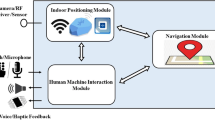Abstract
Aiming at the problem of limited beacon coverage and low positioning accuracy when indoor WiFi and Bluetooth are positioned separately, the fusion positioning algorithm of indoor WiFi and Bluetooth based on discrete mathematical model is studied. The position fingerprint method is used to realize WiFi indoor positioning through two stages of “off-line/training” and “on-line positioning”. The intensity of Bluetooth is obtained through Gauss distribution model. The intensity of Bluetooth signal and the relationship between the distance corresponding to Bluetooth and signal intensity are used to obtain the positions of multiple groups of points to Bluetooth nodes. And then the final positioning coordinates of users are obtained by centroid algorithm. The prior location results and distribution are obtained by multi-source prior information fusion between WiFi and Bluetooth. The optimal Bayesian posterior distribution density function is used to estimate the coordinate deviation, which is used to correct the fusion positioning results and obtain the optimal estimation of the coordinates of WiFi and Bluetooth fusion positioning. The experimental results show that the algorithm can locate indoor volunteers with a positioning accuracy of more than 98% and a positioning time of less than 5 s, which has a high positioning performance.





Similar content being viewed by others
References
Ciabattoni L, Foresi G, Monteriù A, Pepa L, Pagnotta DP, Spalazzi L, Verdini F (2019) Real time indoor localization integrating a model based pedestrian dead reckoning on smartphone and BLE beacons. J Ambient Intell Hum Comput 10(1):1–12
Claessens T (2017) Finding the location of the instantaneous center of rotation using a particle image velocimetry algorithm. Am J Phys 85(3):185–192
Guo H, Zhang H (2016) Development of double-pair double difference earthquake location algorithm for improving earthquake locations. Geophys J Int:333–348.
Haixia C, Lianming W (2017) Sensor node localization based on artificial bee colony algorithm optimizing support vector machine. J of Jilin Univ (Sci Ed) 55(3):647–651
Li X, Wang L, Wang J, Zhang X (2017) Multi-focus image fusion algorithm based on multilevel morphological component analysis and support vector machine. IET Image Proc 11(10):919–926
Ma WX, Fuchssteiner B (1999) Algebraic structure of discrete zero curvature equations and master symmetries of discrete evolution equations. J Math Phys 40(5):2400–2418
Marinelli B, Bishay V, Ranade M, Nowakowski F, Fischman A, Lookstein R, Patel R (2018) 4: 21 PM Abstract No. 130 An automatic nonrigid co-registration algorithm for fusion of cone-beam computed tomography and magnetic resonance imaging: feasibility in Y90 radioembolization for hepatocellular carcinoma. J Vasc Intervent Radiol 29(4): 58–59.
Rech PC (2019) Organization of the periodicity in the parameter-space of a glycolysis discrete-time mathematical model. J Math Chem 57(2):632–637
Shen YX, Wu J, Wu DH (2017) Fault diagnosis technology for three-level inverter based on reconstructive phase space and SVM. Power Supply 15(6):108–115
Škrekovski R, Dimitrov D, Zhong J, Wu H, Gao W (2019) Remarks on multiplicative atom-bond connectivity index. IEEE Access 7(1):76806–76811
Sundar D, Sendil S, Subramanian V, Balasubramanian V (2019) WALE: a weighted adaptive location estimation algorithm. J Ambient Intell Hum Comput 10(7):2621–2632
Tan C, Ji S, Gui Z, Shen J, Fu DS, Wang J (2018) An effective data fusion-based routing algorithm with time synchronization support for vehicular wireless sensor networks. J Supercomput 74(3):1267–1282
Tseng PH, Lee KT (2016) A femto-aided location tracking algorithm in LTE-A heterogeneous networks. IEEE Trans Veh Technol 66(1):748–762
Wang Q, Zhang YC, Ban YM (2018) Research of distribution power supply fault location system based on Android. Chin J Power Sour:130–131.
Xu Y, Yu H, Zhang J (2018) Fusion of inertial and visual information for indoor localisation. Electron Lett 54(13):850–851
Yao X, Chen L, Peng L, Chi T (2017) A co-location pattern-mining algorithm with a density-weighted distance thresholding consideration. Inform Sci:144–161.
Yao X, Chen L, Wen C, Peng L, Yang L, Chi T, Yu W (2018) A spatial co-location mining algorithm that includes adaptive proximity improvements and distant instance references. Int J Geograp Informat Sci 32(5):980–1005
Zhang CJ, Liu C, Guo Q (2017) Simulation of abnormal node data location in large data network environment. Comput Simulat:273–276.
Zhao HY, He JW, Wa WH (2017) The single station geometric positioning technology of airborne infrared system for sea surface targets. J China Acad Electr Inform Technol:410–413.
Zhao C, Yu LX, Wan J (2017) Research on terminal location algorithm for power production environment. Automat Instrum:12–15.
Zhao J, Guo J, Cheng W, Xu C, Huang L (2017) Assessment of SPOT-6 optical remote sensing data against GF-1 using NNDiffuse image fusion algorithm. Mod Phys Lett B 31(19–21):1–7
Zhou H, Zhou H, Zhang H, Ge X, Zhao Y, Lin W (2017) Pressure measurement based on multi-waves fusion algorithm. IET Sci Meas Technol 11(3):354–362
Author information
Authors and Affiliations
Corresponding author
Additional information
Publisher's Note
Springer Nature remains neutral with regard to jurisdictional claims in published maps and institutional affiliations.
Rights and permissions
About this article
Cite this article
Zhang, F. Fusion positioning algorithm of indoor WiFi and bluetooth based on discrete mathematical model. J Ambient Intell Human Comput (2020). https://doi.org/10.1007/s12652-020-02635-2
Received:
Accepted:
Published:
DOI: https://doi.org/10.1007/s12652-020-02635-2




